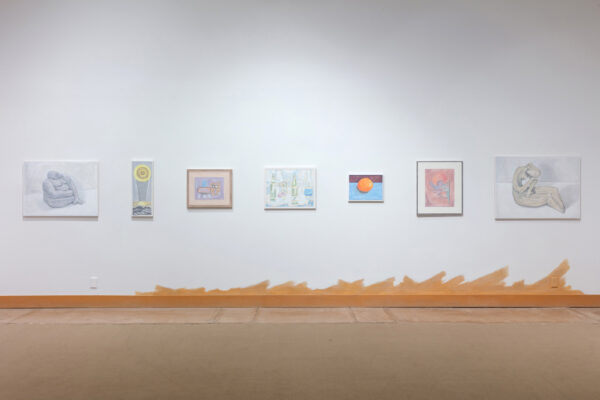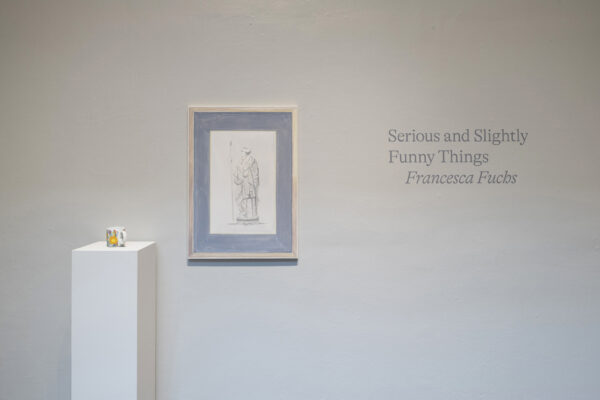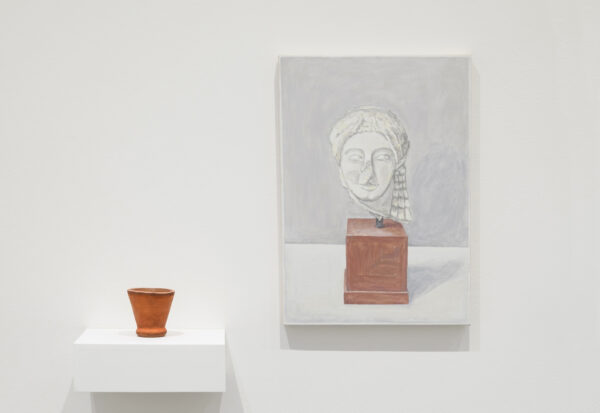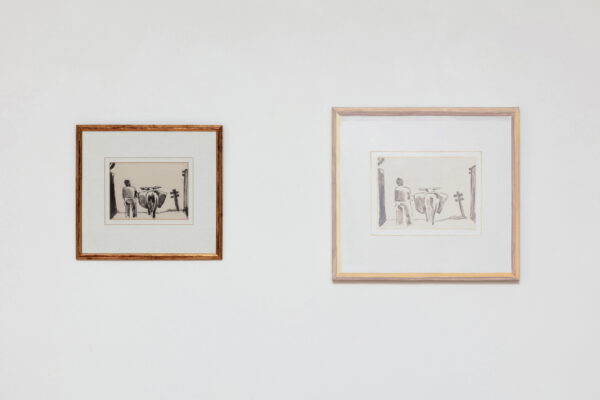
Francesca Fuchs, Installation view, “Francesca Fuchs at The Suburban at the OJAC,” 2022, Old Jail Art Center, Albany, TX. photo credit: Kevin Todora.
To say 2022 has been a busy year for Francesca Fuchs would be an understatement. Over the course of the year, the Houston-based artist and Glassell School of Art instructor has had solo exhibitions at the Art Museum of Southeast Texas (AMSET), Inman Gallery and the Old Jail Art Center (OJAC). In addition to fulfilling the various installation responsibilities for each, she has also attended the related receptions, presented gallery talks, and signed exhibition catalogs.
Taking a moment to reflect on it all, she recently shared with me some thoughts about Francesca Fuchs at The Suburban at the OJAC, which remains on view through the end of January 2023, as well as further insights into her shows Serious and Slightly Funny Things and how a rock is all about surface. Fuchs also keyed me in on what she is currently working on for 2023.
Caleb Bell (CB): At the end of 2021, you opened Serious and Slightly Funny Things at the Art Museum of Southeast Texas in Beaumont, which kicked off 2022. How did the title for the show come about and what did it reference?
Francesca Fuchs (FF): Serious and Slightly Funny Things reflected the show in so many ways. It was how it felt at that moment in the pandemic; it was how the exhibition felt — it had been postponed at that point two times; and more than anything, it was how the objects in the exhibition felt — their weird conversations, and my attempt to blend the floor into the wall in two places. There was something heroically impossible in that gesture that was serious and slightly funny.

Francesca Fuchs, installation view, “Francesca Fuchs at The Suburban at the OJAC,” 2022, Old Jail Art Center, Albany, TX. Photo credit: Kevin Todora.
CB: That idea of extending the floor onto the wall has continued in your subsequent exhibitions. Can you elaborate on your thoughts behind that gesture? What are you hoping visitors take away from that experience?
FF: Even though the gestures have this obvious connection of starting from the floor up, they all felt very different. Serious and Slightly Funny Things was trying to make visible the impossible, blurring space and objects, like in Biese 3, pulling a color from the painting and extending it into a turquoise swoosh on the wall. In Gray Floor, the gesture was barely noticeable and it made the gallery into an unstable space, where things could be suspended for a moment in time. This exhibition was about the emotional power of objects. I wanted the paintings to have an aura that would exceed the power of the objects themselves. Shifting the floor just slightly in this very painterly gesture brought touch and care into the place from which we experience the world, the surface we stand on.
The wall painting in Francesca Fuchs at The Suburban at the OJAC was not about a blurring. I was creating a landscape of sorts for the paintings over the very prominent orange-brown baseboards. I plan meticulously, and this one was unplanned. I needed to do it, but was truly unsure if it would work. It felt like falling off a wall and not knowing where the bottom was: terrifying and deeply exciting. I came back a day early for the opening, ready to change it or paint it out, and found that it was perfect.

Francesca Fuchs, installation view, “Serious and Slightly Funny Things,” 2021, Art Museum of Southeast Texas, Beaumont, TX. Photo credit: Paul Hester.
CB: A catalog was produced by AMSET in conjunction with Serious and Slightly Funny Things. I firmly believe you can only understand how much goes into producing a publication if you have worked on one. In my experience, regardless of size, the process tends to be fairly time-consuming and meticulous, but once your book is in hand, it is sort of magical. How does it feel to have this exhibition memorialized with such a substantial publication?
FF: It was a real labor of love. Designer Amanda Thomas and I worked very closely together to find its shape and language. So many gorgeous decisions were made by Amanda. We wanted something intimately handheld that was also surprising. I wanted it to feel like an actual work rather than a catalog. At this moment in the pandemic, it was important that any publication would feel necessary.
The first half of the book has 23 descriptions written by me, one on each individual work in the exhibition and one description of the exhibition as a whole. I wanted the writing to reveal another, a different layer of looking with care, of knowing and not knowing an object. The descriptions are bookended with an essay by Dean Daderko on attention and memory. It is like a journey through the work to another journey of remembering. I think we managed to keep the book so particular by keeping the decisions very close — it was mostly Amanda and me working with care and attention, and Laura August encouraging and editing with a beautiful and light hand. The Art Museum of Southeast Texas was extremely generous in supporting the publication and just letting us do our thing. That is rare.

Francesca Fuchs, “Kore and Orange Cup,” 2022, oil paint over fired clay, shelf, acrylic on canvas. photo credit: Paul Hester.
CB: In Serious and Slightly Funny Things and then how a rock is all about surface, which opened later at Inman Gallery, you paired some paintings with mugs. Can you share your thoughts regarding the visual dynamic as well as the physical relationship created between them?
FF: That is one of those slightly funny things. The mugs and paintings add to each other and they jostle one another. They do not sit comfortably together and yet they completely belong. The mugs are hand-built in clay, fired, and then thickly painted with oil paint. I paint them like a painting, I paint their shadows. By contrast, the paintings are very thinly painted. At Inman, each painting was of a different figurative sculpture, one a plaster cast of a Greek votive head, the other of a sculpture my son made of a head with a transforming eye sitting on an upholstered cushion. In the juxtaposition of mug and painting, there is a question about presence. About what is here in space with you and what is not. They also all ask questions about value and importance. The two mugs at Inman were made specifically for those paintings. They play with color, form, physicality, and scale, as well as touch and connection.

Left: Josef Herman, “On the Way Home,” 1958, ink wash on paper. Right: Francesca Fuchs, “Framed Drawing: Man with Donkey,” 2014, acrylic on canvas. Installation view at the Old Jail Art Center, Albany, TX. Photo credit: Kevin Todora
CB: In your most recent exhibition, Francesca Fuchs at The Suburban at the OJAC, which opened this fall at the Old Jail Art Center in Albany, the work is slightly different from these earlier two exhibitions. Instead of painting objects that you have a personal relationship with, you focused on works specifically from their permanent collection. Can you please share your thought process behind that shift? Also, how did you go about selecting the works from their collection to focus on?
FF: The show at Old Jail opened six months after Serious and Slightly Funny Things closed. I did not want to reinstall Serious and Slightly Funny Things — that constellation of work was so particular, it could only be disappointing. There was no way all the work could be new — the galleries are too extensive, and I was not interested in a named, mid-career retrospective. I wanted the exhibition to resonate within the place and community.
I decided the exhibition would be a giant conversation around painting, with its kernel a remaking of a solo exhibition at The Suburban in Oak Park, Illinois in 2013 (I know, it’s complicated). To extend the conversation into place and community, I looked through the online database of the OJAC. I wasn’t sure if I would be interested in making paintings of things in the collection, but decided to pick ten pieces intuitively and make some sketches. My focus was on modernist abstractions, women, vessels, nature, but also a sense of power and place. I was surprised how interested I was. I was now painting my imaginings of the work rather than my memory of it, such a similar but wildly different thing. And I met some gorgeous work this way — especially a Flora Blanc Reeder gouache was a revelation.
CB: Presenting these three exhibitions within a year, I am sure you have discovered some new things about yourself and the work. Are there any major takeaways when reflecting on this past year?
FF: The three exhibitions in the past year came out of a time of major change and upheaval in the world and for me personally, as well as a time of reflection. I have so much gratitude for the quiet at the Dora Maar residency in the summer of 2021, with its permission to work with unbroken focus. My major takeaway is gratefulness for the people with whom I collaborate, whether these are folks I spend time with because I know and love them, or people whose work I read, look at, experience, and admire from afar. To me, artmaking is a confluence and collaboration — an ongoing conversation within my work and with that of others. I don’t want to have a conversation where all I do is talk. I want audible gaps, echoes, half formed sentences, funny things, and blunt “thereness.” More than anything, I want to keep collaborating and move into places I don’t know — especially (even) if I am falling off a wall.
CB: As we look ahead to 2023, are there any projects in the works that you would like to share?
FF: I am collaborating with curator Annette DiMeo Carlozzi and poet Joanna Klink on a project which will open at testsite in Austin on February 26. It fills me with joy to work closely with these two amazing women, and I can already feel how resonant the project will be for me. I am also so grateful to testsite, whose mission for 20 years has been to present “these projects as they are germinating, or at a stage of fruitful exploration and healthy doubt integrated within the corners, shelves, walls and rooms of an intimate space.” In some ways, it’s the perfect site for the kind of questions that most interest me.
This interview has been lightly edited for length and clarity.
***
Francesca Fuchs at The Suburban at the OJAC is on view at the Old Jail Art Center in Albany through January 28, 2023. Serious and Slightly Funny Things was on view at the Art Museum of Southeast Texas in Beaumont from December 17, 2022, through March 13, 2022. how a rock is all about surface was on view at Inman Gallery in Houston from January 15 through March 12, 2022.


